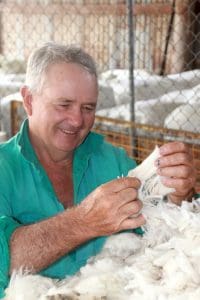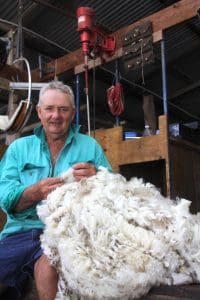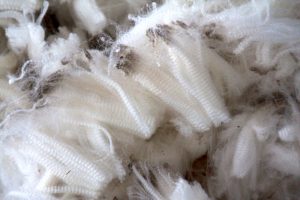
Shearing earlier to produce a shorter staple length is proving to be a worthwhile move for Sandy Smith.
Building dog-proof boundary fencing is just one change some Traprock district fine woolgrowers have been making to improve their profitability.
Some are also breaking with tradition and are now shearing three times every two years.
The move has reduced costs while maximising wool production.
In years gone by woolgrowers were discounted for selling fleece wool with a staple length much shorter than the preferred 100mm.
However, more wool processors are increasingly chasing fine wool with a 65-70mm staple, which they say better suits their spinning and knitting processes.
In response to this trend, producers like Sally and Sandy Smith at Allendale near Gore, west of Warwick, have recently moved from a 12-month to eight-month shearing cycle.
The Smiths have just finished shearing their second eight-month clip last week.
The shorter growing interval produces a 65-70mm staple length.
Fleece weights per head averaged 3.41kg this shearing. The average was lowered by the inclusion of 450 wethers with six months wool, which were shorn to be brought into line with the rest of the flock, and 1400 fine wool 16 micron wethers.
Test results from their June shearing last year (the latest clip is yet to be tested) included staple strength at 65 newtons per kilotex and close to 80pc yields.
Benefits
The Smiths say they are finding numerous benefits from the move.
For a start, Mr Smith says, most of the quality issues that cause losses for growers, such as cotting or fly strike, tend to occur in the final third of the growing season when fleeces are at their longest.
But significant cost-savings are the biggest benefit.
At first the idea of adding more shearing costs may sound counter-intuitive.
But that extra cost is only part of the story.
Shearing at shorter intervals means fewer shed staff are required. The cleaner nature of the shorter clips and the particular requirements of this market means less skirting and in-shed preparation is needed, compared to conventional clips.
The majority of wool goes into a single fleece line, so there is no longer the need for, and cost of, a classer, and at least one or two traditional shed staff.
Second, shearing every eight-months means crutchings between shearings can also be eliminated.
Any sheep approaching wool-blindness can be trimmed in the race during drenchings between shearings.
As a result the Smith’s total annual shearing costs of around $8.50 per head ($7 for shearing and $1.50 for crutching) have been reduced down to around $4.50 a head.
Strong sale-room demand
After making the change for the first time last year, Mr Smith and a group of other Traprock growers travelled with their broker, Bruce McLeish from Elders (who is also a Traprock woolgrower) to Sydney last July to watch their shorter-length clips sell at auction.
“It certainly got very good competition, the demand was clearly there,” Sandy said.
“There was no discount (for the shorter length wool).
“You probably don’t get any more money, but I don’t think you get any less.”
Another benefit is that it seems that shearing more often is also promoting faster wool growth, or at least increasing the amount of wool being cut per head per year.
The 3.41kg fleece weight average from his latest 16-18 micron clip translates annual fleece production per head of 5.1kg.
In the past, annual cuts from fine wool wethers on Allendale have averaged 3.5-4.5kg, and 4.5-5kg for medium wool wethers.
Another advantage of the eight-month shearing is that it also improves cash flow throughout the year.
Downsides?
So, what are the downsides?
Just 12 months into the experiment, Sandy says he hasn’t been able to identify too many yet.
He concedes that being able to find shearers every eight months could be a problem in future, but it hasn’t been so far.
 Sandy has traditionally shorn in summer, and the new eight-month cycle means some future shearings will inevitably have to occur in the colder months of winter. However, many growers successfully shear in winter in cold climates so this is not a “game breaker”.
Sandy has traditionally shorn in summer, and the new eight-month cycle means some future shearings will inevitably have to occur in the colder months of winter. However, many growers successfully shear in winter in cold climates so this is not a “game breaker”.
There is also a risk that this smaller market segment may eventually become swamped with over-supply.
However Sandy is not convinced that will happen.
Shearing more regularly is better suited to the smaller number of producers who run wether-only operations, as many in the Traprock region do, rather than those with breeding operations.
While it is possible to juggle the demands of sheep breeding with more regular shearings, and some growers manage it successfully, the strategy is less complicated for those who don’t have to work around annual joinings and lambings.
“You are probably never going to get an over-supply because 90pc of the flock is ewes (breeding operations), and a lot of people can’t be bothered to manage joining and lambing with an eight month shearing,” Sandy said.
“Some do it, they bring their joining forward a month or drop it back a month, but I can’t see too many doing this.”
Like other long-term woolgrowers who have stuck with Merinos through the long, low-price wool stockpile hangover years, Sandy is very pleased to see record prices now being paid for wool.
While the higher prices also mean growers have to pay more to buy wethers, the resurgence in prices is a welcome reward for decades of commitment to producing the lustrous natural fibre.
Wool from the Smith’s shearing which finished last week will sell in Sydney next week, and they are hoping the market holds its recent strength until then.




This preparation is minimal; shanks, crutch and tight jowls are removed on the raised board, skirting over 50 percent of the fleece. The portions left are minimal, as where the belly is broken out either side of the fleece and don’t need skirting, as there is no frib. The balance of light skirting is similar length and free with no tightness or heavy vegetable matter. Very similar to the fleece, proven by co-efficients of variation of lengths of 14 to 17, commonly found in traditionally-prepared fleece lines.
Correct re: No AWEX stencil, minimum standard for clip preparation, fleece wool must be skirted. As the wool is not skirted, it is non-conforming for AWEX, but all standards are adhered to; stain removed and classed =two to three ways on length and color; the same principles of preparing lamb and weaner wool apart from skirting 40pc of the fleece.
These wools are tested and sold under a “D certificate ” in the normal sale catalogue. The buyers are aware by the “D cert” and can judge the risk for themselves, usually showing U1 (light skirt) in the AWEX ID. This preparation method will only be a small part of the national clip, as traditional ewe joining timetables complicate shearing every eight months, but can be done with some changes in management. Full names required in future for reader comments please Ange, as per our long-standing comments policy: https://www.sheepcentral.com/about-us/sheep-central-comment-policy/ Editor.
I am not against an eight month shearing cycle, but at least explain that you cannot pick up and throw the fleece on the wool table for proper skirting. That is why you get less skirtings, the rest are in the fleece line. With less shed staff it is not really a quality job. With avoiding the cost of a classer, you must be selling the clip without an AWEX-registered wool classer’s stencil, that is not allowable.